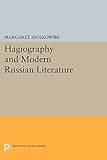Hagiography and Modern Russian Literature / Margaret Ziolkowski.
Material type: TextSeries: Princeton Legacy Library ; 902Publisher: Princeton, NJ : Princeton University Press, [2014]Copyright date: ©1988Edition: Course BookDescription: 1 online resource (282 p.)Content type:
TextSeries: Princeton Legacy Library ; 902Publisher: Princeton, NJ : Princeton University Press, [2014]Copyright date: ©1988Edition: Course BookDescription: 1 online resource (282 p.)Content type: - 9780691604657
- 9781400859405
- Christian hagiography
- Christian saints in literature
- Hagiography in literature
- Russian literature -- History and criticism -- 19th century
- Russian literature -- History and criticism -- 20th century
- Russian literature -- 19th century -- History and criticism
- Russian literature -- 20th century -- History and criticism
- LITERARY CRITICISM / Russian & Former Soviet Union
- 891.7/09/3522 19
- PG3015.5.H34 Z7 1988eb
- online - DeGruyter
- Issued also in print.
| Item type | Current library | Call number | URL | Status | Notes | Barcode | |
|---|---|---|---|---|---|---|---|
 eBook
eBook
|
Biblioteca "Angelicum" Pont. Univ. S.Tommaso d'Aquino Nuvola online | online - DeGruyter (Browse shelf(Opens below)) | Online access | Not for loan (Accesso limitato) | Accesso per gli utenti autorizzati / Access for authorized users | (dgr)9781400859405 |
Frontmatter -- CONTENTS -- PREFACE -- NOTE ON TRANSLITERATION AND DATES -- ABBREVIATIONS USED IN THE NOTES -- CHAPTER ONE: Introduction -- CHAPTER TWO: Hagiography and History: The Saintly Prince in the Poetry of the Decembrists -- CHAPTER THREE: Hagiography Revised: Adaptations of Legends and Tales -- CHAPTER FOUR: Neo-Hagiography: The Saintly Monk and the Holy Fool in Modern Dress -- CHAPTER FIVE: Hagiography and the Rigorous Hero: The Josephite Type in Later Russian Literature -- CHAPTER Six: Anti-Hagiography: Tolstoy's Assault on Orthodoxy -- CONCLUSION
restricted access online access with authorization star
http://purl.org/coar/access_right/c_16ec
The heritage of medieval hagiography, the diverse and voluminous literature devoted to saints, was much more important in nineteenth-century Russia than is often recognized. Although scholars have treated examples of the influence of hagiographic writing on a few prominent Russian writers, Margaret Ziolkowski is the first to describe the vast extent of its impact. Some of the authors she discusses are Kondratii Ryleev, Aleksandr Bestuzhev-Marlinskii, Fedor Dostoevsky, Leo Tolstoy, Nikolai Leskov, Gleb Uspenskii, Dmitrii Merezhkovskii, and Maksimilian Voloshin. Such writers were often exposed to saints' lives at an early age, and these stories left a deep impression to be dealt with later, whether favorably or otherwise.Professor Ziolkowski identifies and analyzes the most common usages of hagiographic material by Russian writers, as well as the variety of purposes that inspired this exploitation of their cultural past. Tolstoy, for instance, employed hagiographic sources to attack the organized church and the institution of monasticism. Individual chapters treat the influence of hagiography on the poetry of the Decembrists, reworkings of specific hagiographic legends or tales, and the application of hagiographic conventions and features to contemporary characters and situations.Originally published in 1988.The Princeton Legacy Library uses the latest print-on-demand technology to again make available previously out-of-print books from the distinguished backlist of Princeton University Press. These editions preserve the original texts of these important books while presenting them in durable paperback and hardcover editions. The goal of the Princeton Legacy Library is to vastly increase access to the rich scholarly heritage found in the thousands of books published by Princeton University Press since its founding in 1905.
Issued also in print.
Mode of access: Internet via World Wide Web.
In English.
Description based on online resource; title from PDF title page (publisher's Web site, viewed 30. Aug 2021)


